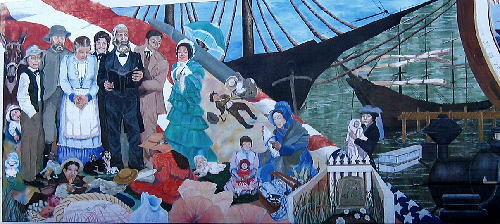The Origin of the Name of One of California’s Oldest Cities
Founded in 1850, Antioch is one of California’s oldest cities. At the time though it was known as Smith‘s Landing after two of its first residents, Rev. Joseph H. Smith and his brother, W. W. Smith.
They initially homesteaded what was called New York Landing, roughly today’s Pittsburg, on 10 riverfront acres apiece given to them by the first American settler in the area, a Dr. Marsh.
The Gold Rush and California’s annexation into the Unites States boosted the township’s population.
On July 4, 1851, 30 to 40 men, women and children attended a holiday picnic at which W. W. Smith suggested the town give itself a biblical name in honor of his recently deceased brother, the reverend.
Antioch was chosen.

(This mural commemorating the event by Charlotte Downs-Siska was commissioned to celebrate the 125th anniversary of cityhood.
Antioch, previously in Syria, now modern day Antakya in Turkey, features prominently in the Bible. It was also, for a time, the third largest city in the Roman Empire after Alexandria and Rome itself with a population of over 500,000.
The city was built around 300 B.C. by Seleucus I Nicator, one of Alexander’s generals, along the Orontes River and is named for a member of Nicator’s family.
Antioch is also the origin of the word “Christian,” according to Acts 11:25-26.
Barnabas brought Paul there after the former persecutor of Christians had his conversion on the road to Damascus. The two preached there for a year, the Bible says.
Antioch is also the site of a public argument between Paul and Peter, “Cephas,” over accepting Gentiles into the faith – Galatians 2:11, 14. According to the Gospel of John, Jesus gave Peter the name “Cephas,” which means rock in Aramaic.
An earthquake in 526 A.D. severely damaged Antioch and it’s port, Seleucia Pieria. Neither ever recovered. Crusaders conquered the city in 1098.
When Egyptian Mamluks took the city in 1268, they massacred the Christian population. By 1432, there were only 300 inhabited houses within the city’s walls.
Antioch California is more famous for its coal, discovered in 1859 by rancher William Israel while cleaning out a spring about six miles south of the city.
For 40 years the Mount Diablo coalfield was the most extensively mined coal deposit in the state, the Black Diamond Vein being the most famous.
Acquired by the East Bay Regional Park District in 1972, the mines and the nearby Rose Hill Cemetery can be toured.
It’s said that at night near the mines, the sound of shovels and tools can still be heard, scraping and clacking over the voices of men speaking in foreign languages.
Sarah Norton, the widow of Noah Norton, founder of a nearby mining town, supposedly haunts the cemetery.
A midwife, she was killed in October 1879 on the way to deliver a baby when her buggy turned over and crushed her.
Norton reportedly did not want a “Christian burial” but the townspeople tried to give her one twice, both times thwarted by sudden storms. Rather than try again, they simply buried her at Rose Hill.
Sightings have been logged for many years.
Some call her the “White Witch” because she appears as a white figure walking among the tombstones.
-30-
Filed under: California History
- Capitol Cliches (16)
- Conversational Currency (3)
- Great Moments in Capitol History (4)
- News (1,288)
- Budget and Economy (383)
- California History (139)
- Demographics (11)
- Fundraising (74)
- Governor (122)
- Legislature/Legislation (270)
- Politics (173)
- State Agencies (38)
- Opinionation (36)
- Overheard (246)
- Today's Latin Lesson (45)
- Restaurant Raconteur (21)
- Spotlight (110)
- Trip to Tokyo (8)
- Venting (184)
- Warren Buffett (43)
- Welcome (1)
- Words That Aren't Heard in Committee Enough (11)

Tomorrow: Wilmore City.
Comment by SugarMuffin — 2.08.2011 @ 12:17 pm